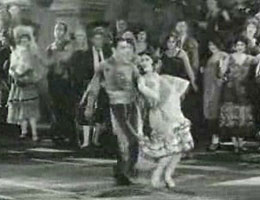 Anna Case stars in the Vitaphone one-reeler La Fiesta (1926). It opens on a raucus opera stage, crowded with the Metropolitan Opera Chorus, to music provided by the Vitaphone Symphony Orchestra conducted by Herman Heller.
Anna Case stars in the Vitaphone one-reeler La Fiesta (1926). It opens on a raucus opera stage, crowded with the Metropolitan Opera Chorus, to music provided by the Vitaphone Symphony Orchestra conducted by Herman Heller.
A male member of the cast strides back & forth in front of the rest of the cast as if searching for something, dressed rather like a gaucho, then dances & minces about the stage. Momentarily he is joined by a woman & they peform an aggressive variation of a tango, often face to face in romantic embrace.
These two dancers are Gitano Spanish-gypsy dancers, who billed themselves as "the Cansinos." Here they are a husband-wife team, but later Eduardo Cansino did the same act with his daughter Margarita, when the rough-trade romanticism of their style became horrifyingly inappropriate. Margarita though only eight years old is reportedly somewhere amidst the big cast on stage, but I could not spot a kid.
Eduardo with his husband & wife team in the 1920s, then father & daughter in the 1930s, worked the vaudeville circuit. Eduardo & Margarita performed in dangerous clubs in Mexico, & on notorious gambling ships off the California coast. Eventually they made inroads into the Hollywood film industry. In the 1930s, Margarita with her name shortened to Rita Cansino appeared in several tiny parts.
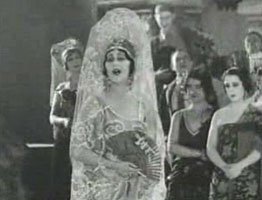 Those who met Margarita Cansino already a dancer at age twelve & thirteen, then as Rita Cansino while still in her teens, said she was absurdly shy, despite the overtly sexual nature of her dance. When she spoke, she spoke so quietly you could hardly hear her. And her first marriage was to a man her father's age. All behaviors typical of molested daughters. Those who met Margarita Cansino already a dancer at age twelve & thirteen, then as Rita Cansino while still in her teens, said she was absurdly shy, despite the overtly sexual nature of her dance. When she spoke, she spoke so quietly you could hardly hear her. And her first marriage was to a man her father's age. All behaviors typical of molested daughters.
Eventually she got electrolosis to move her hairline further up her forehead, so she looked less like a cave woman. Her name was changed one more time, to Rita Hayworth, & soonafter she became her father's enemy, suing him in court for her earnings as a child & teenager, but very likely small revenge for other things.
The gypsy dance completed, the opera chorus then sings anew & throughout we hear the Vitaphone Symphony Orchestra, from which we see a marimba section in Spanish costume on the upper level of the stage.
The choral singing probably wouldn't've been any good even if it had been recorded better. We're well over halfway through the film before opera soprano Anna Case descends the staircase to the lower stage, dressed as highborn Spanish senorita.
Even with the primitive recording devices, Anna's talent makes it through to the screen & to the ear. She looks rather odd with the caked on make-up, & her stationary physical performance is as dead as her grease paint complexion, but that would've been some voice to hear from a movie screen in days that were essentially still the silent era.
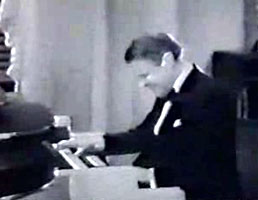 In the 1920s, Jesse Crawford became a well known silent movie organist, for in big cities film organists often had reputations equal to the stars in the films. He was a major draw at Grauman's Milliion Dollar Theater in Los Angeles, then Paramount Theater in New York, the gem of silent film palaces. In the 1920s, Jesse Crawford became a well known silent movie organist, for in big cities film organists often had reputations equal to the stars in the films. He was a major draw at Grauman's Milliion Dollar Theater in Los Angeles, then Paramount Theater in New York, the gem of silent film palaces.
As the silent film era wound down, his connections with cinema exhibitors meant he was able to move into sound-films himself, makign appearances on the big screen, as well as touring America as one of the early popularizers of the Hammond organ over the parlor piano.
He also made Wurlitzer player piano rolls for home play. Completely self-taught, he did not take his first piano or organ lessons until a year after filming Mr. & Mrs. Jesse Crawford at Home (1939).
For films he had learned to create a wide array of sound FX which he transferred to his "novelty" act. His wife Helen also played, & it was their stage act playing twin organs that this Vitaphone short captures.
A dreadful diddy called "Mr. & Mrs. Is the Name" is played behind the opening credits. We're then shown a stage with Jesse & Helen's unusual organ -- it has keyboards on both sides, joined as one huge instrument rather than two separate organs back to back -- in a large music room of their private residence.
A radio producer is present. They're expecting a representative for the Universal Gas Company are on the way to hear the act. If the representative decides to sponsor the Crawfords' show, money will be no object.
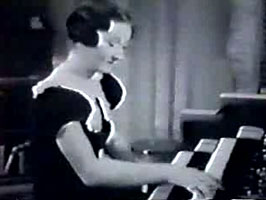 After a knock at the door, the radio producer rushes the gentleman into the music room, where the Crawfords immediately strike up a workmanlike rendition of "Tea for Two." After a knock at the door, the radio producer rushes the gentleman into the music room, where the Crawfords immediately strike up a workmanlike rendition of "Tea for Two."
Because the Hammond company wanted sample performances to be duplicable in the homes of Hammond purchasers, the Crawfords were encouraged to play a lot of chestnuts void of much in the way of interpretation. It sounds like something one might hear in a skating rink.
For their second number they play "When My Dream Boat Comes Home" composed by Cliff Friend & Dave Franklin. Judith Barron -- a minor singer of the Ziegfeld Follies -- strolls into the room to sing the lyrics. It's a squalling frightful performance of a standard other singers have done so much better.
We're only halfway through the one-reel musical. Next up is crooner Bill Johnson (not to be confused with a great jazzman of the same name) doing a rather Bing Crosbyish "The Very Thought of You." It's a pleasing little rendition even if nothing special.
The Crawfords next strike up a skating rink number & a few moments later Judith Barron, seated on a couch, begins to murder the hoary tune "I Love You Truly." Bill Johnson joins in, & there seems to be a whole chorus hiding behind the furniture. The enlarged singing does at least drown out the awful organ music.
All this while the radio producer & man from the gas company have been enjoying the private concert. The film ends with a lame joke & a few organ notes instead of a rim shot.
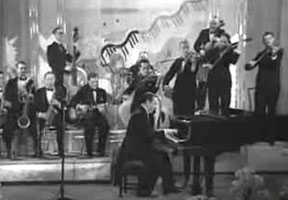 In the 1930s Pathetone in London produced a large number of two to six minute featurettes highlighting bands well known in the dance clubs, niteclubs, or from the radio. In the 1930s Pathetone in London produced a large number of two to six minute featurettes highlighting bands well known in the dance clubs, niteclubs, or from the radio.
One such was Billy Thorburn & His Band (1937), about four minutes of jaunty string-dominated swing band, & Billy on piano. The rhythm section is reeds & a guitar.
The song is the Jimmy Kennedy & Michael Carr composition "There's a New World," a popular hit for the rest of the '30s after it was introduced by Joe Loss & His Orchestra, with vocalist Chick Henderson.
It was initially a "darkie tune" inspired by minstrel shows of the previous decade, but as a Billy Thorburn instrumental it is stripped of the racial racially stereotyped lyrics about watermelons & cotton-pickin' & hallalujas on the River Jordan. The only lyric that would matter in a time of war was "There's a new world free from sorrow/ Free from worry 'bout tomorrow/ We'll be singing when we're starting/ No more parting in this world." Though the lyric was not sung in Thorburn's pure instrumental, the song was well known.
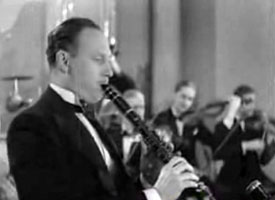 The smartly dressed band is a mite retro for 1937, but this is all to the good. The band seems still under the sway of such American bands as toured England & Europe a decade before, including Eubie Blake & Noble Sissle. The smartly dressed band is a mite retro for 1937, but this is all to the good. The band seems still under the sway of such American bands as toured England & Europe a decade before, including Eubie Blake & Noble Sissle.
And Billy had himself been performing since the early '20s, though his own band as seen here was formed only in 1936, lasting into the 1950s. And despite the film's title his orchestra was actually called Billy Thorburn & His Music, as the announcer at the beginning states.
The bouncy ragtime beauty of the opening number gives way to a second tune, "No Regrets," for which the clarinet deeply dominates for a slow dance, & much closer to the band's usual sound. The standing clarinetist sets down his instrument & picks up a sax as he takes his seat in the bandstand, right as the film cuts to Billy on piano for a tinkly solo. Strings fill out the background arrangement. It's very sweet.
Then the guitarist puts aside his instrument, leaps up from the bandstand & hurries front center to a microphone to sing:
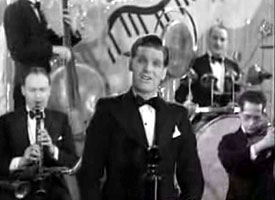 "No regrets/ Although our love affair has gone astray/ No regrets/ I know I'll always care though you're away/ Somehow our happy romance ended suddenly/ Still in my heart you'll be forever mine/ "No regrets/ Although our love affair has gone astray/ No regrets/ I know I'll always care though you're away/ Somehow our happy romance ended suddenly/ Still in my heart you'll be forever mine/
"No regrets/ Because somebody new looks good to you/ No regrets/ Sweetheart no matter what you say or do/ I know our love will linger when the other love forgets/ So I say goodbye with no regrets."
A darned delightful tune reminscent of Rudy Vallee though this guy, Ken Crossley, has a sweeter voice than Rudy's. Crossley had been bricklayer whose real name was Kenneth Hodgkinson. He had been a singer at Nottingham's Victoria Ballroom, when he had a very local repuation sing with Billy Merrin & His Commanders. He had only begun his recording career the year he made this little film with Billy Thorburn, having had his first big break at the Cocoanut Grove, & touring with Montavani.
His success looked firm but wartime performers were more than averagely prone to vaguaries & impositions. By late 1939 he had to return to his bricklaying trade. Drafted into the Royal Signal Corp in 1940, he was captured in the Pacific & brutalized in a Japanese prisoner camp. After the war he opened a music shop in London & did not attempt to recapture his career as a singer & band guitarist.
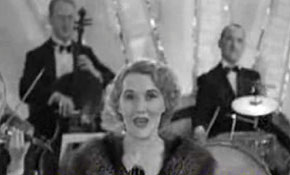 Filmed at the same time on the same stage, Billy Thorburn & His Music (1937) actually mispells his name as "Thornburn" on the title card. The film opens with another jaunty instrumentation, much more 1920s than '30s, & all the more sweet for its retro character.
Filmed at the same time on the same stage, Billy Thorburn & His Music (1937) actually mispells his name as "Thornburn" on the title card. The film opens with another jaunty instrumentation, much more 1920s than '30s, & all the more sweet for its retro character.
A second number slows down & has some of the effect of a children's tune, strings & Billy's piano dominant. Then out comes vocalist Helen Raymond to unveil the lyrics for this sweety-pie number:
"It happened on the beach at Bali Bali/ I found him dreaming on the golden sand/ It happened on the beach at Bali Bali/ It wasn't long till we were holding hands.
"And while we strolled along the beach together/ We kissed & then he promised to be mine/ You could've knocked me over with a feather/ When he told he told me that he came from Caroline.
"The day I sailed across the ocean/ To find romance across the sea/ I never had the slightest notion/ I'd find the boy who used to live next door to me.
"And now we've got a cottage in the valley/ A little something else that's his & mine/ It happened on the beach at Bali Bali / And ended on the beach in Caroline."
Helen exits the stage as Billy & his band finish it off with that kiddy-like cuteness. This singer was an American singer-actress from Philadelphia, a performer on Broadway. She went to England at the height of the war & ended up with a following on both sides of the Atlantic.
The Brits genuinely appreciating that she would risk air raids to perform in London, besides donating much time to entertain the war-wounded. Her last stage appearance was in the 1957 original Broadway cast for The Music Man.
copyright © by Paghat the Ratgirl
|
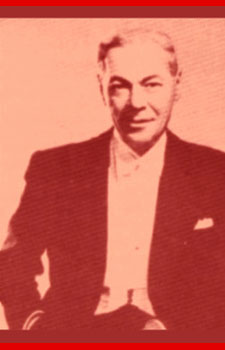

 Those who met Margarita Cansino already a dancer at age twelve & thirteen, then as Rita Cansino while still in her teens, said she was absurdly shy, despite the overtly sexual nature of her dance. When she spoke, she spoke so quietly you could hardly hear her. And her first marriage was to a man her father's age. All behaviors typical of molested daughters.
Those who met Margarita Cansino already a dancer at age twelve & thirteen, then as Rita Cansino while still in her teens, said she was absurdly shy, despite the overtly sexual nature of her dance. When she spoke, she spoke so quietly you could hardly hear her. And her first marriage was to a man her father's age. All behaviors typical of molested daughters.
 After a knock at the door, the radio producer rushes the gentleman into the music room, where the Crawfords immediately strike up a workmanlike rendition of "Tea for Two."
After a knock at the door, the radio producer rushes the gentleman into the music room, where the Crawfords immediately strike up a workmanlike rendition of "Tea for Two."
 The smartly dressed band is a mite retro for 1937, but this is all to the good. The band seems still under the sway of such American bands as toured England & Europe a decade before, including Eubie Blake & Noble Sissle.
The smartly dressed band is a mite retro for 1937, but this is all to the good. The band seems still under the sway of such American bands as toured England & Europe a decade before, including Eubie Blake & Noble Sissle. "No regrets/ Although our love affair has gone astray/ No regrets/ I know I'll always care though you're away/ Somehow our happy romance ended suddenly/ Still in my heart you'll be forever mine/
"No regrets/ Although our love affair has gone astray/ No regrets/ I know I'll always care though you're away/ Somehow our happy romance ended suddenly/ Still in my heart you'll be forever mine/